HARD FRUIT (detail)
Hard Fruit
(Apples -PLums-Pears Cherries) etc)
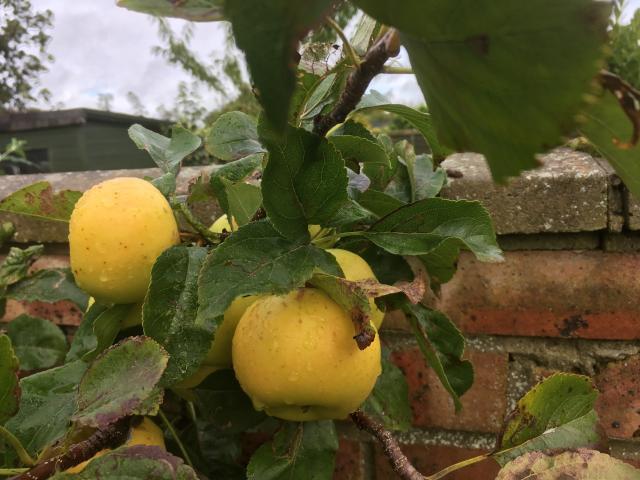
Greensleeves A fully Mature "Greensleves" Dual purpose Apple
This apple variety is "By far"my most favoured COOKING variety. This apple will hold its shape when cooked and has a sound apple texture and flavour, making it ideal for Flans and apple pies. More importantly when fully ripened to the lemon yellow colour, it requires NO added sugar, if you prefer a quite sharp eating apple give it a try.
Most of the advice given here may relate to mature (over 5 year old trees)
Fred's Apple choice
In my opinion these are all really nice apple varieties worthy of your consideration all are readilly available from reputable growers, but may rarely be found on supermarket shelves.
"James Grieve" a very nice crisp juicy flavourful apple
"Egremomt Russet" a nice eating apple with distinct Russet texture with a rich flavour.
“El Star" Probably my favourite eating apple, can be bi annual, that is it may do well one year and perhaps less well another year but still worth appearing on "my favourites"
"Kids Orange Red" a really nice crisp eating apple with good wholesome apple texture and flavour flavour.
"Ashmeads Kernel" good eater and cooks well- also cider option
"Pitcarnis Pineapple" -very small fruit between golf ball and tennis ball size but delicious faintly pineapple flavour. A spendid apple,If you can harvest enough fruit’s , and have the facilities available to you , this variety in my opinion makes the best ever apple juice!!
"Royal Norfolk Russet"a very nice eating apple with that distinct Russet texture
"Ribston Pippin" similar "to Cox’s Pippin" but just a shade crisper
"Clay gate Permain" a nice firm very tasty eating apple similar to above
My personal preferred supplier are "mailordertrees"
This suplier provvides consistently high quality disease free trees 3-4 year old potted up tree and they tend to fruit within the first year after delivery- at least a year ahead of most other suppliers I have tried (this factor may be reflected in the slightly higher price) I think it's worth every penny! They will also offer trees on a wide variety of specified rootstocks. Specifically the M26 rootstock with a 3 metre height lmitation as preferred, in fact specified, by GY&GAA as maximum permitted growth height.
JUNE DROP
During the last week of May and much of June- apples ,pears ,plums and some cherries will discard up to 30% of their imature fruit crop . This is commonly referred to as the June drop. These fruit trees (when mature and fruit bearing) instinctively sense they cannot possibly carry all their pollinated fruit to maturity and so randomly discard it. This ptocedure ensures MOST of the remaining fruits may grow to a moderate size.
Thininng your Fruit
To enhance your crop AFTER THE JUNE DROP it is reccommmmended that during JULY, YOU THIN OUT much of the remaining fruit.
It is therefore reccomended that eating apples are reduced to no more than 2 fruits per truss, obviously you would choose the larger stronger looking fruit, snip off very carefully all other applets!
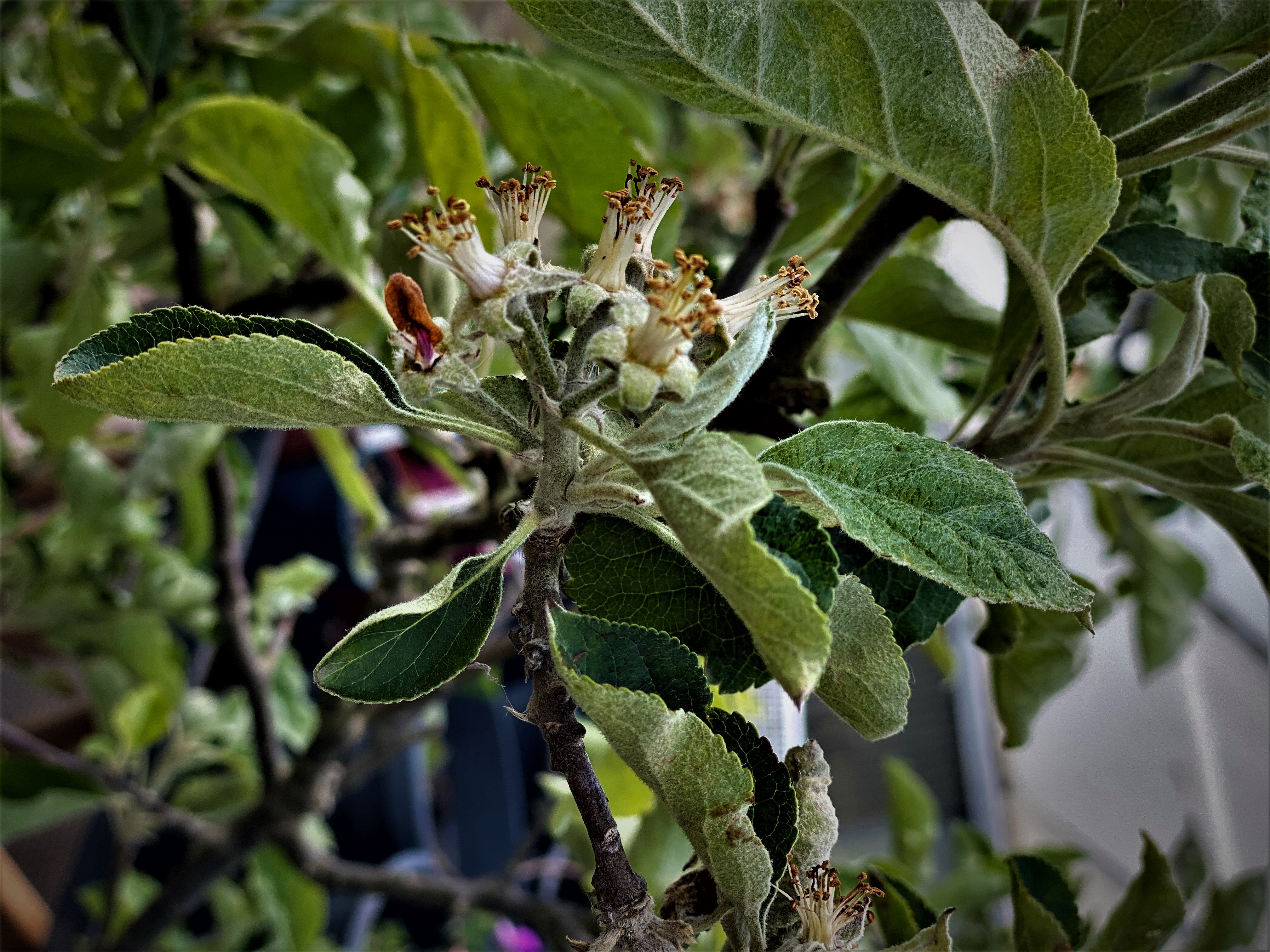
this does sound quite dramatic BUT failure to do this will result in many fruits in too close proximity becoming diseased and losing everything.
You do ned to do this very carefully with small scissors/clippers
Less fruit- will allow them to grow larger and stronger and hopefully remain disease free. Your actual remaining mature "yeild" of mature fruit will probably be much higher than if you do nothing! Cooking apples should be reduced to ONE fruit per truss - eating applescan be reduced to TWO fruits per truss, all of the above reasons apply.
A similar pruning policy may be applied to plums PARTICLARLY but with pears exclude the thinning , pears do not normally over produce beyond the already discussed JUNE DROP.
It may be worth noting that many pear varieties fail to achieve full maturity in a UK climate,however as experienced by the summer of 2022 things are changing markedly.
it is possibly fair to say 22 was TOO hot for most crops and facilities to provide copious watering during the hottest months may be well advised!!
Viral infections which may affect Apple trees
This is merely a few detrimental viral infections I have found some ways to deal with- I make no guarantees of success or eradidication merely some control.
Blossom Wilt on Apple trees
Where spring blossom and any new growth dries out and dies. this is quite rare but may just happen once in a trees lifetime, if there is evidnce of a regular affliction. CONSIDER the tree's renoval as it may well spread this virus. OR the tree may recover the folowing season and lead a normal productive lifecycle.
Carefully remove any affected foliage-blossom etc and BURN IT
DO NOT PUT IT ON THE COMPOST BIN
Wash your hands -clear up any fallen material and take any precautions necessary to avoid carrying any spores into next year
There are apparently no known chemical cures for this disorder!!
(if you have any better info olease email me onezip@hotmail.co.uk)
Wooly Aphid
An aphid that is almost invisible to the eye which colonizes on apple trees like cotton wool- and will spread uncontrollably without some treatment to the detriment of fruit production and health of the fruit tree.
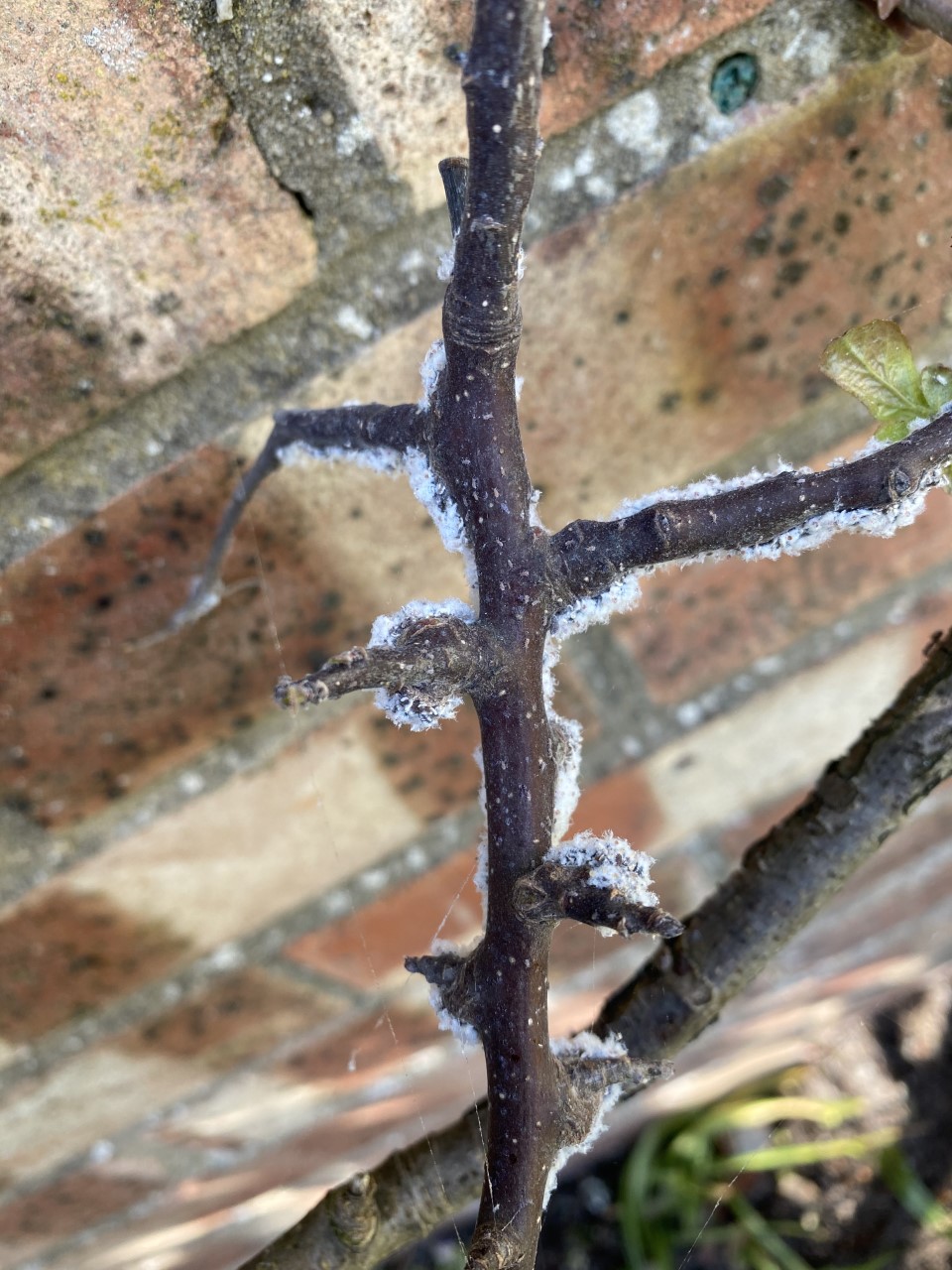

wooly aphid fungus Again! There is no apparently obvious commercial preventative of this fungus.
This may be distributed by birds but more likely by using secateurs that have not been properly disinfected, again methylated spirit on a price of kitchen roll and thoroughly wipe blades after each cut.should solve the issue.
I may however have found a treatment that removes the immediate issue WITHOUT harming the surrounding growth or the fruit production. Much advice is to just wash it off -this would only serve to compound the problem-the gunk needs to be permanently removed, otherwise it will simply reinfect from where it lands.
My method of using “Methylated Spirit “ Using a piece of Kitchen roll, liberally coated with "meths", carefully remove/wipe off the offending “gunk” from the area and dispose of it by burning or other permanent means. PLEASE do not put it on the compost bin.
This solution is NOT A CURE, but merely an effective means to clean and remove this offensively sticky gunk thereby allowing the tree to survive without any obvious detrimental effect to future growth or fruit production. This procedure may have to be repeated wherever the infestation may recur. It does however SEEM to inhibit future issues over time.
Peronally I have invested in a BROWN BIN SUBSCRIPTION around £47 a year to disposeof all my allotmnent/garden waste OFF SITE which I prefer not to add to my compost heap . This deals permanently with material like sword/couch grass-bindweed-groundsell as well as blight infested potato potato tops and many other nasties that make hard work of an otherwise pleasant pastime. This also reduces/ saves on burning waste and the environmental issues incurred by this action
November is the time to consider fitting GREASE BANDS to Fruit Trees.
ONLY do this if you have identified an issue sthis past season.
IF you have been having issues with some pests (the female "Codling Moth" is flightless)and other bugs and beasties earwigs , slaters, and other NON FLYING insects crawling up the trunk and overwinwintering in bark creviceses where they lay their eggs and the larvae may infest the fruit in spring
Codling Moth
The female Codling Moth is itself flightless, once mated by the Male (the sole target of the Pherimone Trap) she will lay her eggs in the very earliest Spring blossom. These Codling Moth traps need to be in place the instant
(preferably a few days prior) fruit buds begin to open.
These moths leave no evidence of their devastating visit until you bite or cut into an infected fruit ðŸ˜Urghhh yuk!!!!
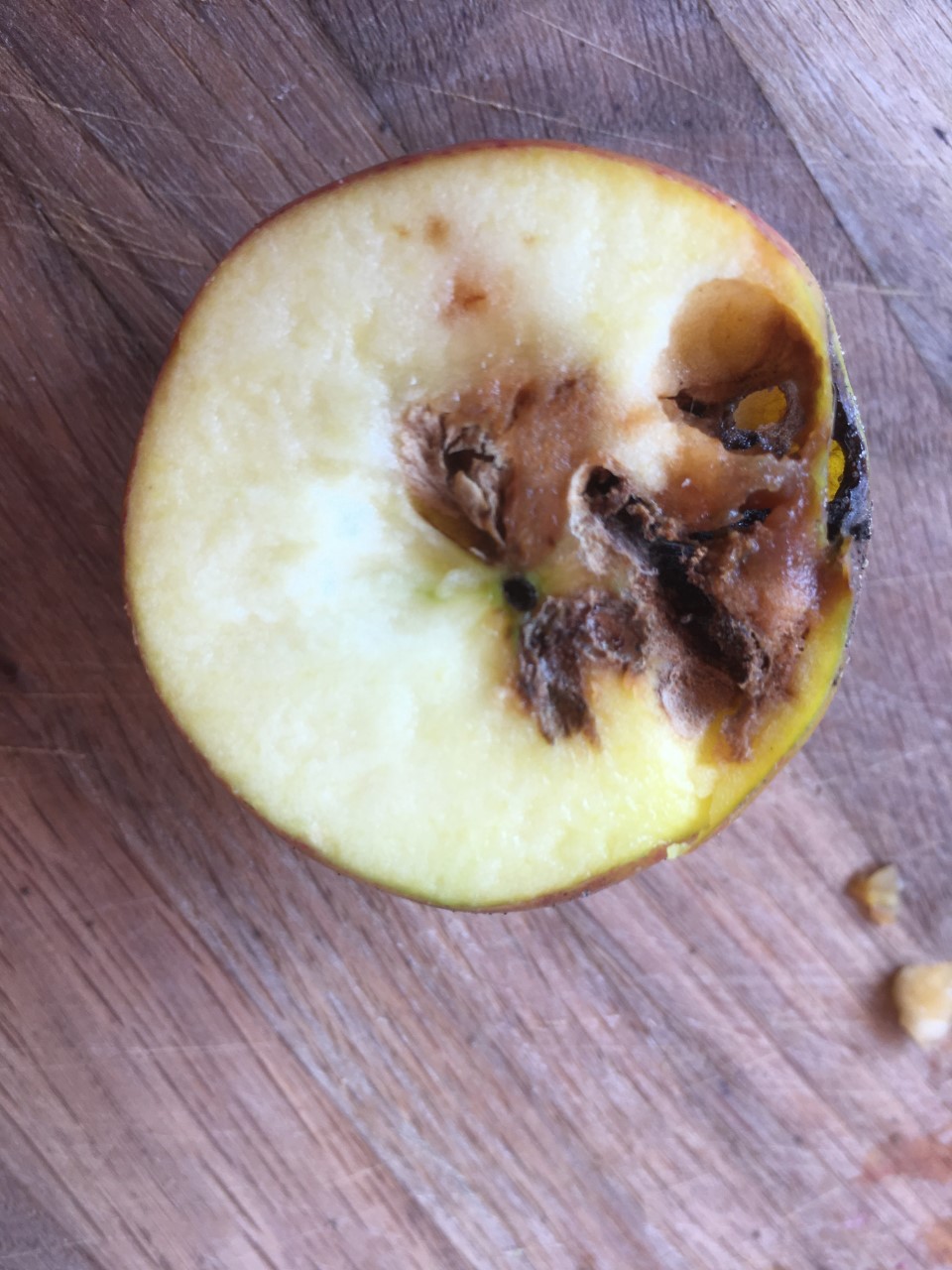
PEARS
Getting Pears to ripen naturally in a uk climate however is quite difficult, our British summer is still aound 3-4 weks too short.. Some "early , varieties ,notably "Williams" may be ready to harest mid to late August .
"Comice " "Concord" and Conference, our most common varieties, may struggle. This makes it neccesary to pick most pears as they are ready and then, ripen them more fully in a more convenient aand conducive environment, ie a kitchen window cill or shed (just make sure they are rodent proof )
To test if a pear is ready to harvest during Mid to Late September try raising the fruit very gently above its customary vertical hanging position to just above vertical , if the stem sanaps readily (no effort is necessary) then it is redy to harvest. Most pears will then reqire aother 7-14 days to ripen off fully. To then test if a pear is ready to eat however, gently press the neck of the pear if it indents readily you will then have a few days to consume rhe pear . More than a few days may lead to a CORE ROT. this condition shows no outward sign of anything untoward until it is cut in half or you take a bite?
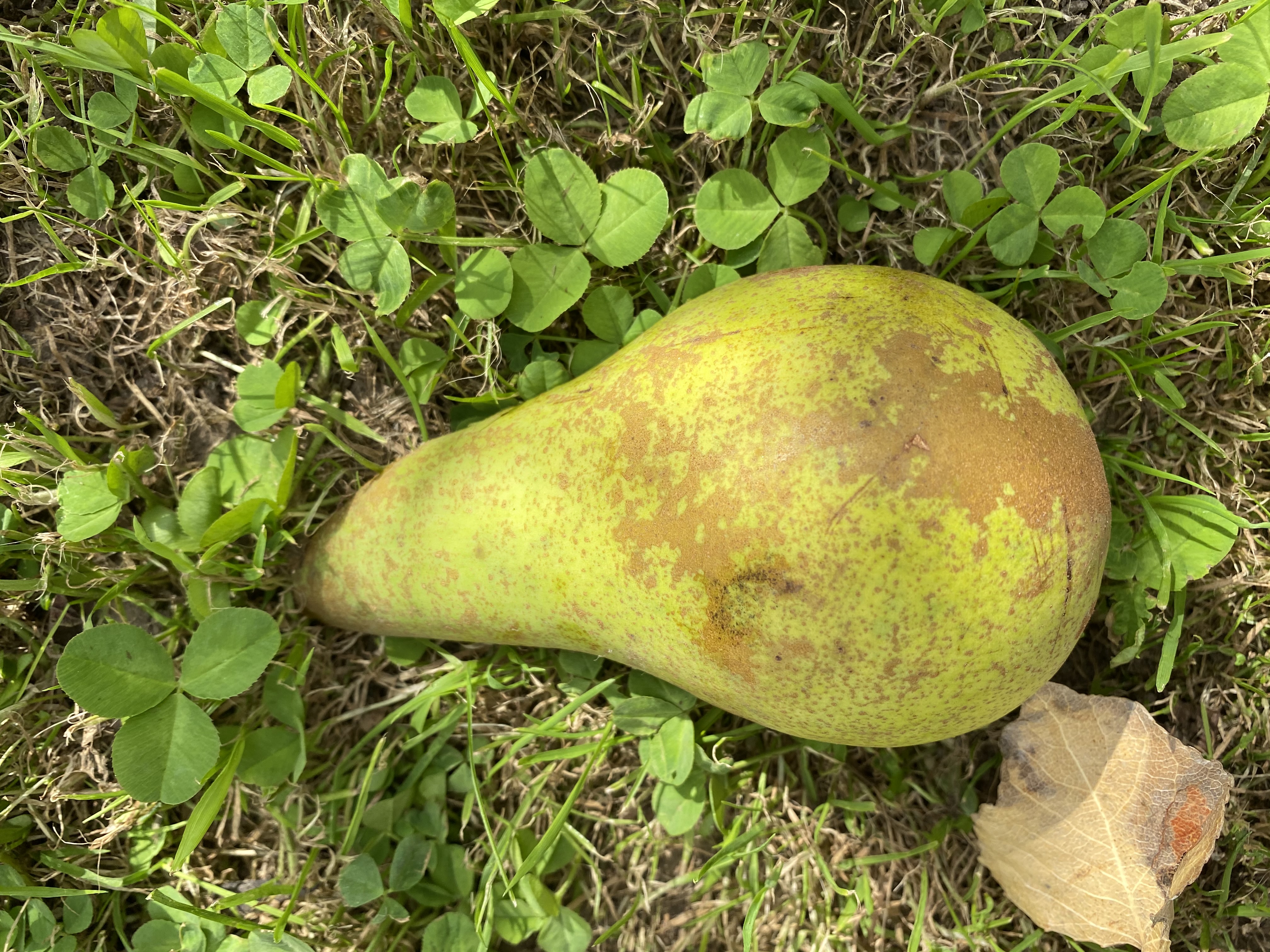
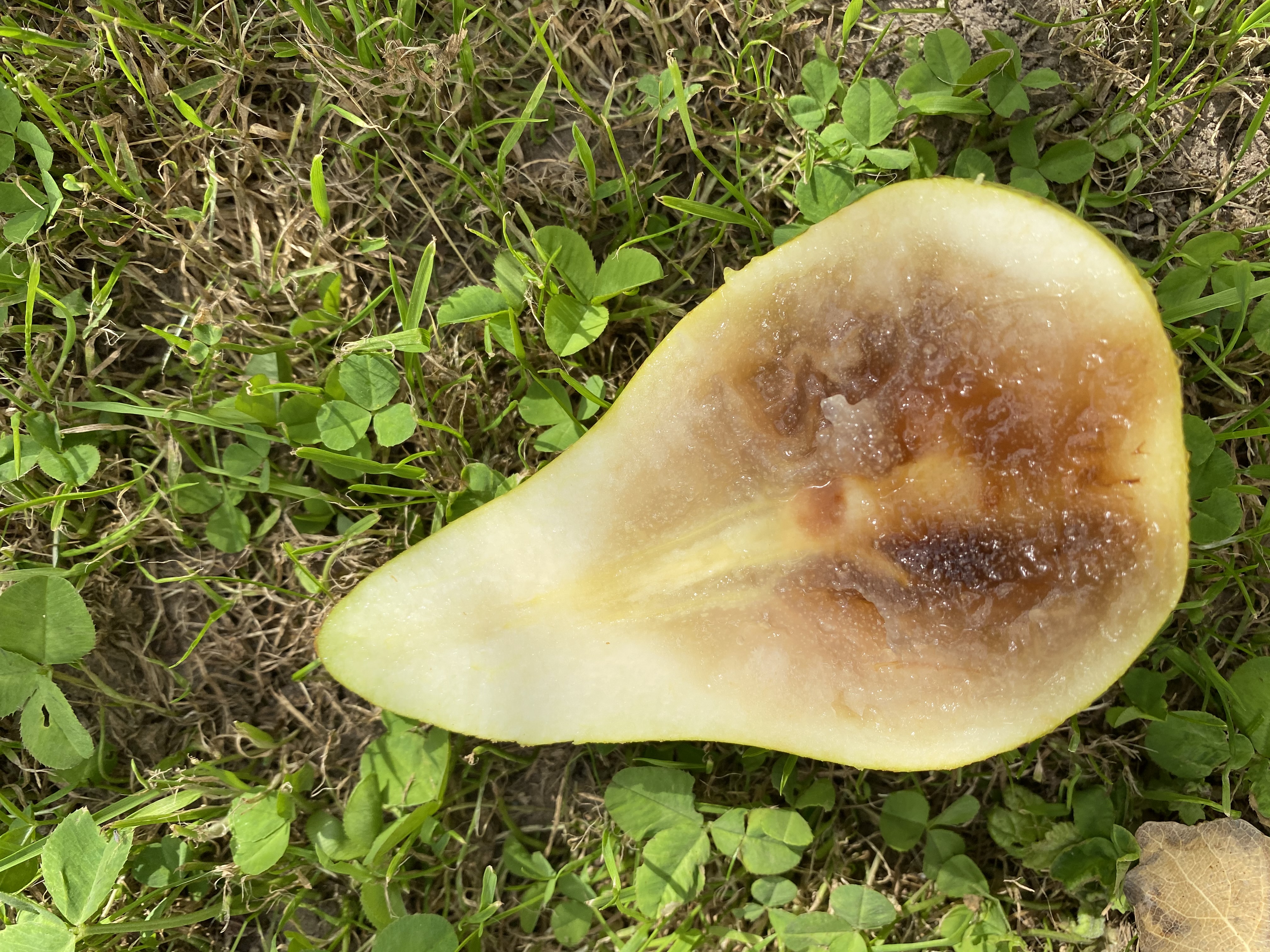 The above shows how a pear can look perfectly sound on the outside-yet inedible on the inside
The above shows how a pear can look perfectly sound on the outside-yet inedible on the inside
Some Plum varirties (where the fruit can hang like a bunch of grapes introcing fermentation and mildew) these need to be carefully thinned
Some other plum varieties may be left without thinning- but only if the fruits are well spaced out
I can only repeat. This all appears a very harsh action but following this advice will provide better, larger tastier fruit in the longer term.

